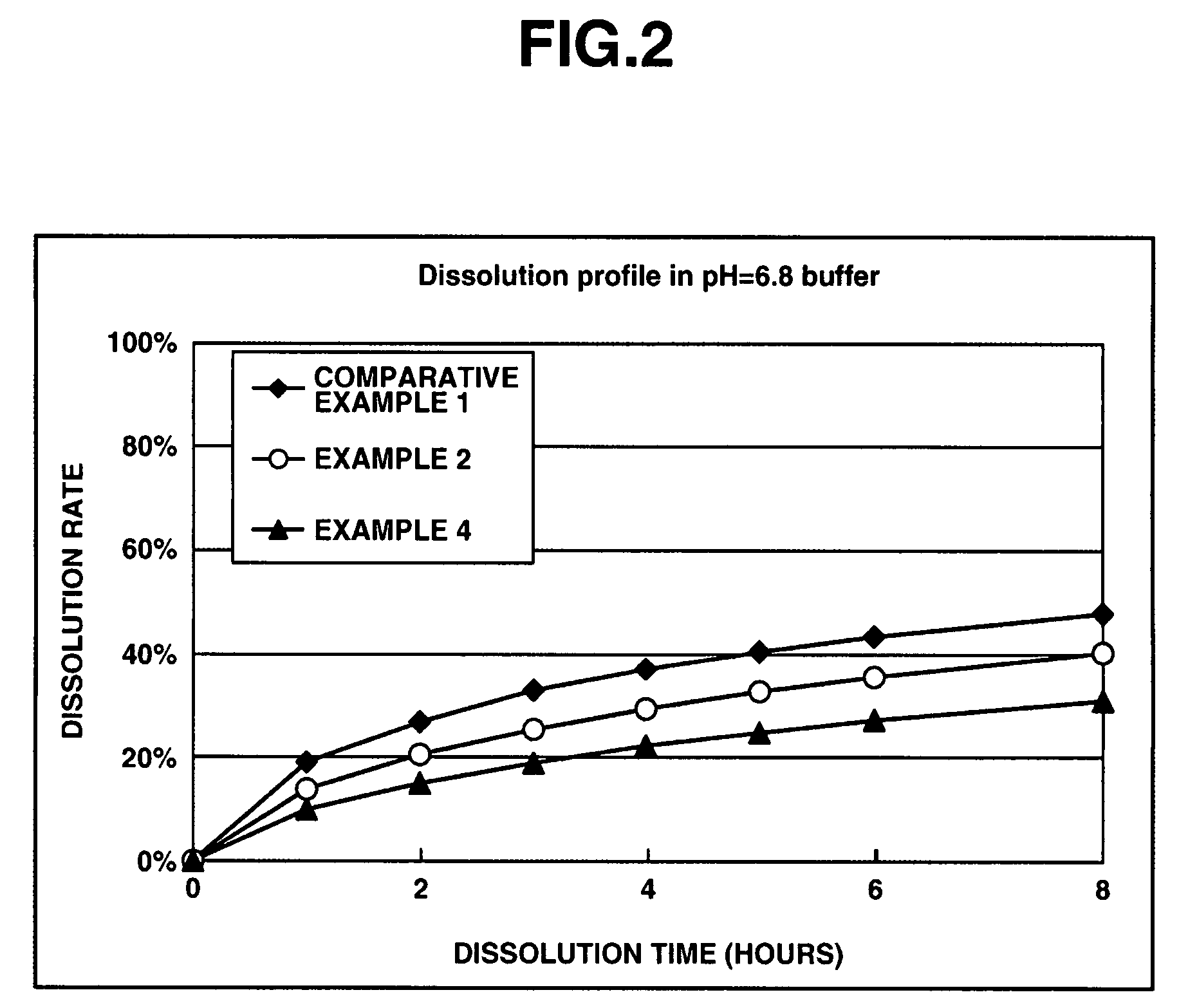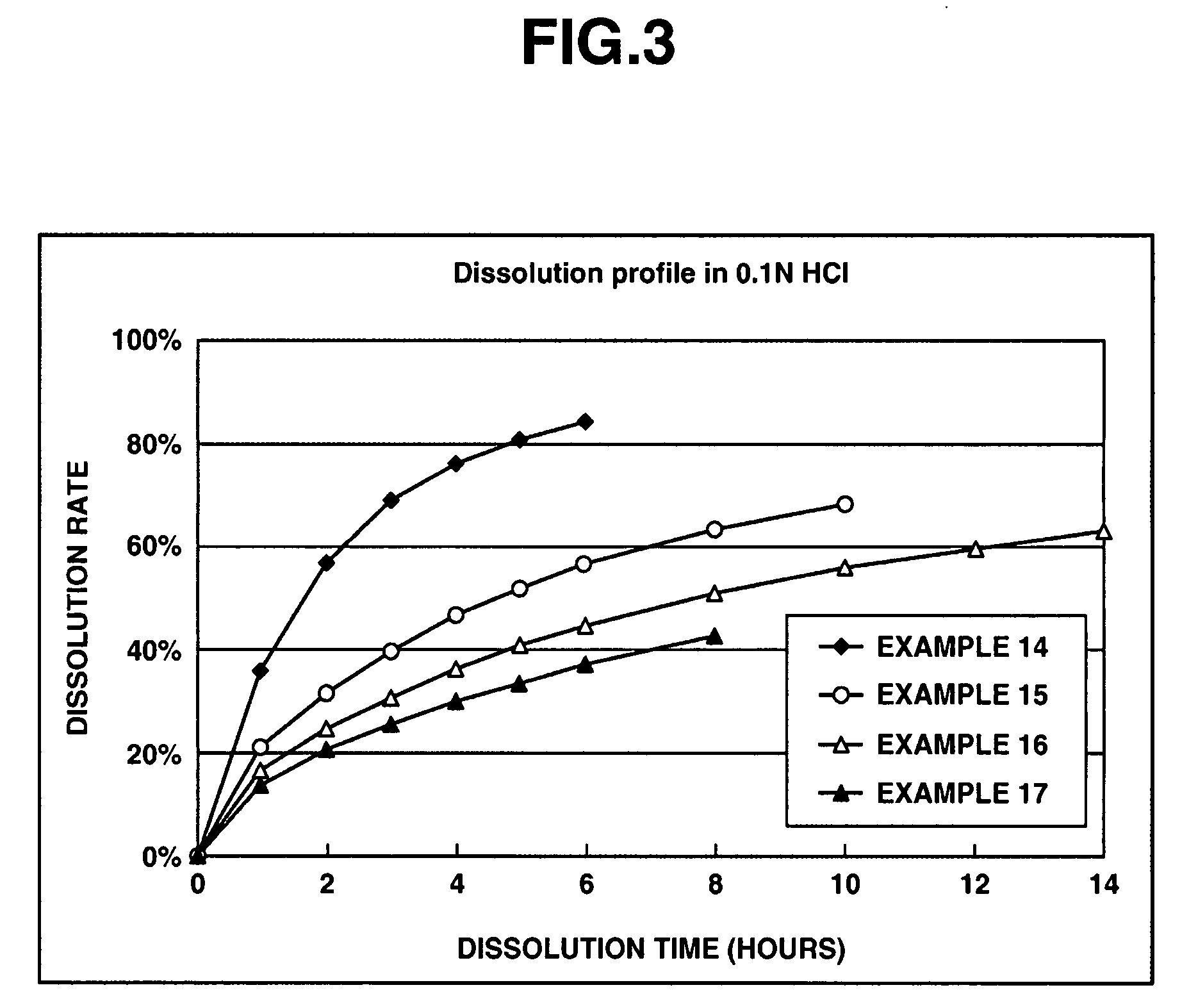Matrix Type Sustained-Release Preparation Containing Basic Drug or Salt Thereof, and Method for Manufacturing the Same
- Summary
- Abstract
- Description
- Claims
- Application Information
AI Technical Summary
Benefits of technology
Problems solved by technology
Method used
Image
Examples
experimental example 1
[0073]In a matrix type sustained-release preparation according to the present invention, effects of an enteric polymer in the presence of a water-insoluble on dissolution behavior are evaluated in the following.
[0074]Matrix type sustained-release preparations were prepared using donepezil hydrochloride according to Comparative Example 1, and Examples 2 and 4 which are given below, and dissolution tests were performed thereon. Note that the matrix type sustained-release preparations were prepared using ethylcellulose as a water-insoluble polymer and Eudragit L100-55 as an enteric polymer. The ratios of ethylcellulose to Eudragit L100-55 in Comparative Example 1, and Examples 2 and 4 were 25%:0% by weight, 25%:25% by weight and 25%:50% by weight, respectively. Further, the dissolution tests were performed in the following two types of test solutions at a paddle frequency of 50 rpm in accordance with the dissolution test methods of the Japanese Pharmacopoeia, Ed. 14. The dissolution te...
experimental example 2
[0080]Set out below are the effects of ensuring dissolution with low pH dependence in the matrix type sustained-release preparation, at the same time, of reducing the ratio of dissolution rate of a basic drug or a salt thereof in an acidic test solution to the dissolution rate in a neutral test solution (dissolution rate in the acidic test solution / dissolution rate in the neutral test solution) in a dissolution test, as the dissolution tests proceed.
[0081]First, Eudragit L100-55 was used as the enteric polymer and ethylcellulose was used as the water-insoluble polymer in the matrix sustained-release preparation.
[0082]Matrix type sustained release preparations were prepared using donepezil hydrochloride according to Comparative Example 1, and Examples 1 through 11 and 14 through 17 below, and dissolution tests were performed thereon. The dissolution tests were performed to evaluate preparations in which the amounts of donepezil hydrochloride, the enteric polymer and the water-insolub...
experimental example 3
[0084]In this experimental example, types of the enteric and the water-insoluble polymers were evaluated for the matrix type sustained-release preparation. First, set out below are experimental examples of the matrix type sustained-release preparations in which hydroxypropyl methylcellulose acetate succinate was used as the enteric polymer and ethylcellulose as the water-insoluble polymer. The matrix type sustained-release preparations were prepared using donepezil hydrochloride according to Comparative Example 2, and Examples 12 and 13 which are given below, and dissolution tests were performed thereon. Hydroxypropyl methylcellulose acetate succinate (AQOAT LF or AQOAT MF; Shin-Etsu Chemical) was used as the enteric polymer and ethylcellulose was used as the water insoluble polymer in the matrix type sustained-release preparations. Note that the amount of hydroxypropyl methylcellulose acetate succinate as the enteric polymer in the preparations was 50% based on the total weight of ...
PUM
| Property | Measurement | Unit |
|---|---|---|
| Fraction | aaaaa | aaaaa |
| Time | aaaaa | aaaaa |
| Time | aaaaa | aaaaa |
Abstract
Description
Claims
Application Information
 Login to View More
Login to View More - R&D
- Intellectual Property
- Life Sciences
- Materials
- Tech Scout
- Unparalleled Data Quality
- Higher Quality Content
- 60% Fewer Hallucinations
Browse by: Latest US Patents, China's latest patents, Technical Efficacy Thesaurus, Application Domain, Technology Topic, Popular Technical Reports.
© 2025 PatSnap. All rights reserved.Legal|Privacy policy|Modern Slavery Act Transparency Statement|Sitemap|About US| Contact US: help@patsnap.com



